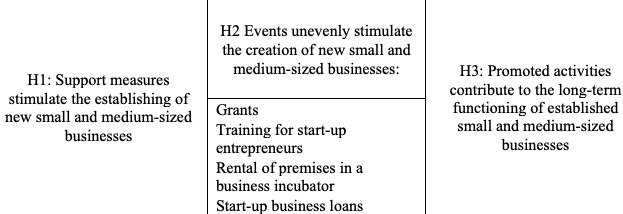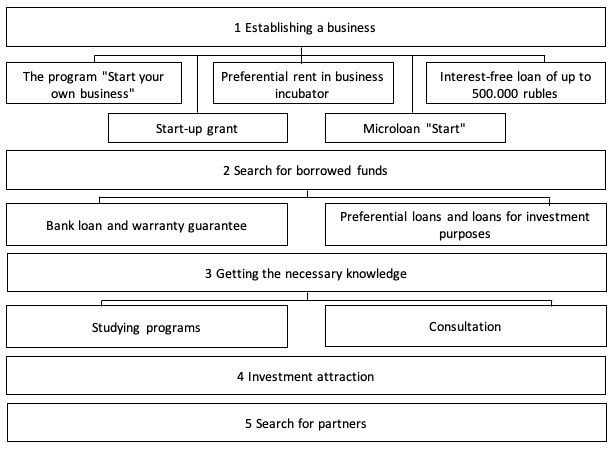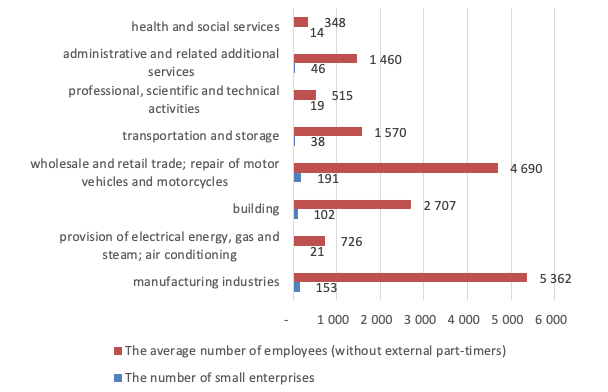

Vol. 40 (Number 25) Year 2019. Page 28
OGORODNIKOVA, Ekaterina S. 1; PLAKHIN, Andrey E. 2; KOCHERGINA, Tatiana V. 3; MIKHAILOVSKY, Petr V. 4; GUSEVA, Tatiana I. 5 & SELEZNEVA, Maria V. 6
Received: 20/04/2019 • Approved: 11/07/2019 • Published 22/07/2019
ABSTRACT: The purpose of this article is to develop and test a methodology for comparative efficiency assessment of the grant support to entrepreneurs in the social sphere, their training and the provision of preferential rent services in regional business incubators. The information base of the research includes registries of support recipients presented on the website of the Regional Fund for the Support of Small Business of the Sverdlovsk Region (https://sofp.ru/) and sampling carried out in the context of support recipients from the online information-analytical SPARK database (http://www.spark-interfax.ru/). The paper proposes the use of measures with a massive coverage of target segments of potential entrepreneurship. The presented study uses a unique set of regional data. Approbation of the method is made on the basis of materials obtained in the course of studies conducted in 2016-2018. The results of the study lead to the conclusion about the greatest impact of the grant support activities for start-up entrepreneurs and provide recommendations for improving the methodology for training managers and specialists of small and medium-sized businesses, since obtaining this type of support does not significantly affect the improvement of performance indicators. |
RESUMEN: El propósito de este artículo es desarrollar y probar una metodología para evaluar la eficiencia comparativa del apoyo otorgado a los empresarios en la esfera social, su capacitación y la prestación de servicios de alquiler preferencial en las incubadoras de empresas regionales. La base de información de la investigación incluye registros de beneficiarios de apoyo presentados en el sitio web del Fondo Regional de Apoyo a Pequeñas Empresas de la Región de Sverdlovsk (https://sofp.ru/) y muestreo realizado en el contexto de beneficiarios de apoyo de la base de datos SPARK de información analítica en línea (http://www.spark-interfax.ru/). Los resultados del estudio llevaron a la conclusión sobre el mayor impacto de las actividades de apoyo a la subvención para emprendedores emergentes y ofrecen recomendaciones para mejorar la metodología de capacitación de gerentes y especialistas de pequeñas y medianas empresas, ya que obtener este tipo de apoyo sí lo hace. No afecta significativamente la mejora de los indicadores de desempeño. El uso propuesto de actividades con una cobertura masiva de segmentos objetivo de potencial emprendimiento. El estudio presentado utiliza un conjunto único de datos regionales. La aprobación del método se realiza sobre la base de los materiales obtenidos en el curso de los estudios realizados en 2016-2018. |
The strategy for the development of small and medium-sized businesses in the Russian Federation for the period up to 2030 outlines the main directions for modifying the support system for small and medium-sized businesses, in particular, the need to take into account individual territorial and sectoral factors. In this regard, the directions of stimulating competition in the social services markets should take into account the specifics of regional markets, this issue was considered in detail in the work by Ogorodnikova (2018).
The theoretical basis for stimulating competition in social markets are theories explaining the definition of effective enterprise size. These include the neoclassical and institutional theory of the firm. Within the framework of these concepts, the role of the existing set of state support measures for entrepreneurship is considered in different ways.
The neoclassical theory of the company considers the optimal size of the enterprise in the form of a production function that forms the economic result as the difference between revenues and costs. As noted by Lundstrom & Stevenson (2006) the increase in production leads to a reduction in unit costs and the possibility of crowding out competitors by reducing the sale price, which is an incentive for a strategy of concentration of participants and the formation of an integrative market structure. The system of state support for entrepreneurs in the social services market used over the past 10 years is characterized by a significant reduction in their fixed costs (loan interest compensation, compensation for expenses on maintaining the resource base, etc.), which negates the effects of scale with an increase in the volume of activities and, accordingly, deprives market participants of the motivation to use the strategy of concentration. In addition to these consequences, an active compensation policy creates pseudo-efficiency of firm operations, leading to a lack of activity in the implementation of innovative and modernization measures that allow for cost reduction. The need to change the nature and forms of state support in connection with the problems outlined above are reflected in the works of Kokovikhin et al. (2018), Karpenko et al. (2011), Yarlykapov & Karpenko (2013), Pshentsova et al. (2015).
We consider the role of the existing set of government support measures in the context of institutional theory, within which the size of a firm is determined not only by operational, but also transactional costs. The term transaction was first used by Williamson (1989) and meant "the act of economic (and not technological) transition from the final point of one technological process to the initial point of another, adjacent to the first." As noted in the work of Nickerson (1997) “For Williamson, the border between administrative-command (typical for a large firm), market and mixed coordination and control mechanisms is mobile and the choice in favor of any of them is the result of comparing their effectiveness in organizing such transitions (transactions), in real life, acting in the form of intra- and interfirm business transactions in a contract form " The impetus for concentration will be savings in transaction costs due to the inclusion of economic relations in the sphere of administrative subordination and, thus, minimization of contractual hazards and management problems. Nickerson (1997) points out that “the theory of transaction costs considers transactions as a fundamental element for determining the structure of an organization, but little can be said about the structure that accompanies transactions and predetermines the actions that must be taken to reduce transaction costs.” Based on the above provisions, a substantial set of compensatory support measures, on the one hand stimulates the maintenance of the size of the business, but on the other hand, deprives the incentive to create integrated structures, since market mechanisms do not act on market participants.
Accordingly, the solution of the problem of stimulating competition can be carried out by
modifying the support system for small and medium-sized businesses. So, in the work Parfenova & Gribovsky (2016) the reason for the low efficiency of small business due to the lack of differentiation of the main measures of state support is indicated, in the work of Yudin (2015) the need to focus the mechanisms of state support for small business towards a differentiated approach is indicated. Such differentiation should be based on objective mechanisms for assessing the effectiveness of government support measures.
We present a methodology for analyzing the effectiveness of state support mechanisms, which is made up of the following system of interrelated hypotheses:
Figure 1
Stages of evaluating the impact of activities aimed at creating a new business

Source: Compiled by the authors
To test the presented hypotheses, the following indicators were used:
1. The share of small and medium-sized businesses that have received support and are valid for 01/01/2019.
2. The share of small and medium-sized businesses that have received support and demonstrate a positive trend in revenue.
3. The share of small and medium-sized businesses that have received support and demonstrate a positive dynamics of assets.
The information base of the research includes registries of support recipients presented on the website of the Regional Fund for the Support of Small Business of the Sverdlovsk Region (https://sofp.ru/) and sampling carried out by the support recipients from the online information-analytical SPARK database (http://www.spark-interfax.ru/).
The Sverdlovsk Regional Fund for the Support of Small Entrepreneurship (hereinafter referred to as the Fund), established in 2002, forms the basis of the multi-level infrastructure to support small and medium-sized businesses. Stimulating competition in the social services market with government support measures includes the blocks presented in Figure 2.
Figure 2
Directions of support for small and medium enterprises carried out by
the regional fund for support of small business in the Sverdlovsk region

Source: Compiled by the authors
The regional infrastructure for supporting small and medium-sized businesses is complemented by a developed municipal infrastructure. At the level of municipalities in the Sverdlovsk region, there are 44 small and medium-sized business support funds and 6 information and consulting centers, 8 business incubators work to support small business start-ups, 2 of which (the Sverdlovsk regional and Krasnoturyinsk business incubators) are established with the involvement of federal budget, and also here operate technology parks. Table 1 presents data on the intensity of support measures.
Table 1
Directions and tools of support small and medium-sized
businesses in the Sverdlovsk region 2016-2017
Directions and tools to support small and medium-sized businesses in the Sverdlovsk region |
Quantity of support measures provided |
|
|
2016 |
2017 |
1. Creating a business |
||
1.1 Rental of premises in the Sverdlovsk regional business incubator |
6 |
|
1.2 Grant to a novice entrepreneur |
200 |
0 |
1.3 Participation in training for start-up entrepreneurs |
711 |
751 |
2. Borrowing funds |
||
2.1 Preferential loan |
4 |
|
2.2 A microloan |
235 |
231 |
2.3 Surety |
346 |
364 |
3. Getting the necessary knowledge |
||
3.1 Consultation |
4 254 |
4 109 |
3.2 Educational services (mass education) |
944 |
763 |
3.3 Implementation of the educational program for individuals under the age of 30 years (inclusive) |
85 |
|
3.4 Assistance in the formulation, protection and use of rights to results of intellectual property |
7 |
13 |
4. Investment Attraction |
||
4.1 Preferential investment loan |
43 |
39 |
4.2 Subsidy to purchase equipment |
108 |
0 |
5. Partner search |
||
5.1 Organization of participation of small and medium-sized businesses in business missions |
43 |
50 |
5.2 Organization of participation of small and medium-sized businesses in exhibitions |
20 |
27 |
5.3 Assistance in organizing participation in exhibitions, fairs and congresses in the Russian Federation and abroad |
19 |
0 |
It should be noted that the level of coverage with support activities is quite small, less than one percent of the number of small and medium-sized businesses in the Sverdlovsk region, which does not approaching the task of managing the territorial and sectoral distribution of newly established small and medium-sized businesses. Also, low intensity does not allow to realize the task of providing a competitive environment in the target markets of social orientation. From table 1 we can see a decrease in the intensity of the use of mechanisms for material incentives for business activities, such as grants for start-up entrepreneurs and the provision of microloans.
Furthermore, in table 2 we present the results of the conducted assessment of the support efficiency for stimulating the establishment of new small and medium-sized businesses in the Sverdlovsk region.
Table 2
Data on the performance of measures for support small and
medium-sized businesses aimed at establishing a new business
Tools of support |
The share of small and medium-sized businesses that have received support and are valid for 01/01/2019, % |
The share of small and medium-sized businesses that have received support and demonstrate a positive trend in revenue, % |
The share of small and medium-sized businesses that have received support and demonstrate a positive dynamics of assets, % |
Rental of premises in the Sverdlovsk Regional Business Incubator |
|||
Legal entities |
100 |
n/d |
n/d |
Individual entrepreneurs |
100 |
n/d |
n/d |
Grant to a novice entrepreneur |
|
|
|
Legal entities |
97 |
85 |
89 |
Individual entrepreneurs |
81,2 |
n/d |
n/d |
Participation in training for start-up entrepreneurs |
|||
Legal entities |
95 |
20 |
35 |
Individual entrepreneurs |
66 |
n/d |
n/d |
Source: Compiled by the authors
As a result of the analysis, we can draw the following conclusions: hypothesis H1: confirmed, indeed, the implementation of incentive measures gives a high percentage of recipients two years after receiving support. In proof of this conclusion, we present the data on the dynamics of the number of small and medium-sized businesses for 2014-2016 in the sectoral context. As can be seen in Figure 3, for the period presented there is an insignificant number of entrepreneurs operating in the social services market, which confirms the low performance of incentive mechanisms for this market.
Figure 3
Indicators of small business in the Sverdlovsk region for 2018

Hypothesis H2: also confirmed. A comparative analysis of the effectiveness of incentive mechanisms for the establishment of new small and medium-sized businesses results in higher rates for entrepreneurs who receive financial support measures, while training does not form a positive trend in revenue and assets in most cases.
Testing hypothesis H3 was carried out on the example of recipients of support in 2016, it can be noted that the most unfavorable picture is observed in the category of recipients , i.e., individual entrepreneurs. Even in the group that received grants, 81.2% are currently active; of those who received training, 66% are active.
Thus, it is impossible to fully assert that the mechanisms for encouraging the establishment of new small and medium-sized businesses ensure that they continue to function steadily.
As a result of the study, it is possible to formulate recommendations for improving training programs for start-up entrepreneurs, it is possible to adapt training programs within the sectoral specifics of the future business, paying more attention to technology issues, the use of modern innovative work technologies, which will allow entrepreneurs to take a better industry position compared to existing participants.
The recommendation concerns the mass coverage of potential entrepreneurs. To do this, it is necessary to use business advertising tools among target segments such as graduates and the unemployed.
It is possible to popularize entrepreneurial activity by attracting successful entrepreneurs to social and educational activities, introducing into educational programs disciplines on social entrepreneurship, creating visual information materials, insignia, etc., personifying social recognition of entrepreneurial activity.
The third recommendation is aimed at improving the mechanisms for supporting the implementation of business activities by newly established small and medium-sized businesses in the long term.
Karpenko, G. G., Yarlykapov, A. B., & Matskulyak, I. D. (2011). State regulation of agroindustrial production: state and development trends in the context of transformation. Herald of the North Caucasus State Technical University, (4), 218-224.
Kokovikhin, A., Ogorodnikova, E., Williams, D., & Plakhin, A. (2017). Institutional Factors in the Evaluation by the Entrepreneur of Municipality Investment Climate. Economy of region, 1(1), 80-92.
Lundstrom, A., & Stevenson, L. A. (2006). Entrepreneurship policy: Theory and practice (Vol. 9). Springer Science & Business Media.
Nickerson, J. A. (1997). Toward an economizing theory of strategy: The choice of strategic position, assets, and organizational form. University of California, Berkeley.
Ogorodnikova, E. (2018). The implementation of the standard of competition. The 12th International Days of Statistics and Economics.
Parfenova, S. L., & Gribovsky, A. V. (2016). Approach to assessing the effectiveness of state support for small innovative enterprises in Russia. The science. Innovation. Education, (4).
Pshentsova, A.I., Mineeva, L.N., Vasilyeva, E.V., Gorbunov, S.I., & Kazakova, L.V. (2015). The impact of state support on the development and efficiency of agricultural enterprises. Polythematic network electronic scientific journal of the Kuban State Agrarian University, (111).
Williamson, O. E. (1989). Transaction cost economics. Handbook of industrial organization, 1, 135-182.
Yarlykapov, A. B., & Karpenko, G. G. (2013). Improving the mechanism of state influence on the agrarian economy and assessing the effectiveness of state regulation of the agro-industrial complex. Economics and Management: problems, solutions, (12), 3.
Yudin, N. S. (2015). Differentiated tools of state support of small business based on its qualitative identification. Socio-economic phenomena and processes, 10 (7).
1. PhD in Economics, Associate Professor, Department of Management, Ural State University of Economics, Scopus Author ID: 57193735098 (62, 8 Marta St., Ekaterinburg, 620144, Russian Federation; e-mail: cmb_8@mail.ru )
2. PhD in Economics, Associate Professor, Department of Management, Deputy Head of the Management and Information Technologies Institute, Ural State University of Economics; Scopus Author ID: 57193735943 (62, 8 Marta St., Ekaterinburg, 620144, Russian Federation; e-mail: apla@usue.ru )
3. PhD in Economics, Associate Professor, Department of Management, Ural State University of Economics (62, 8 Marta St., Ekaterinburg, 620144, Russian Federation; e-mail: kochergina_tv@usue.ru )
4. Doctor of Economic Sciences, Professor, Department of Management, Ural State University of Economics (62, 8 Marta St., Ekaterinburg, 620144, Russian Federation; e-mail: ment@usue.ru )
5. Senior lecturer, Department of Management, Ural State University of Economics (62, 8 Marta St., Ekaterinburg, 620144, Russian Federation; e-mail: t.i.guseva@yandex.ru )
6. Senior lecturer, Department of Management, Ural State University of Economics (62, 8 Marta St., Ekaterinburg, 620144, Russian Federation; e-mail: mvselezneva@yandex.ru )